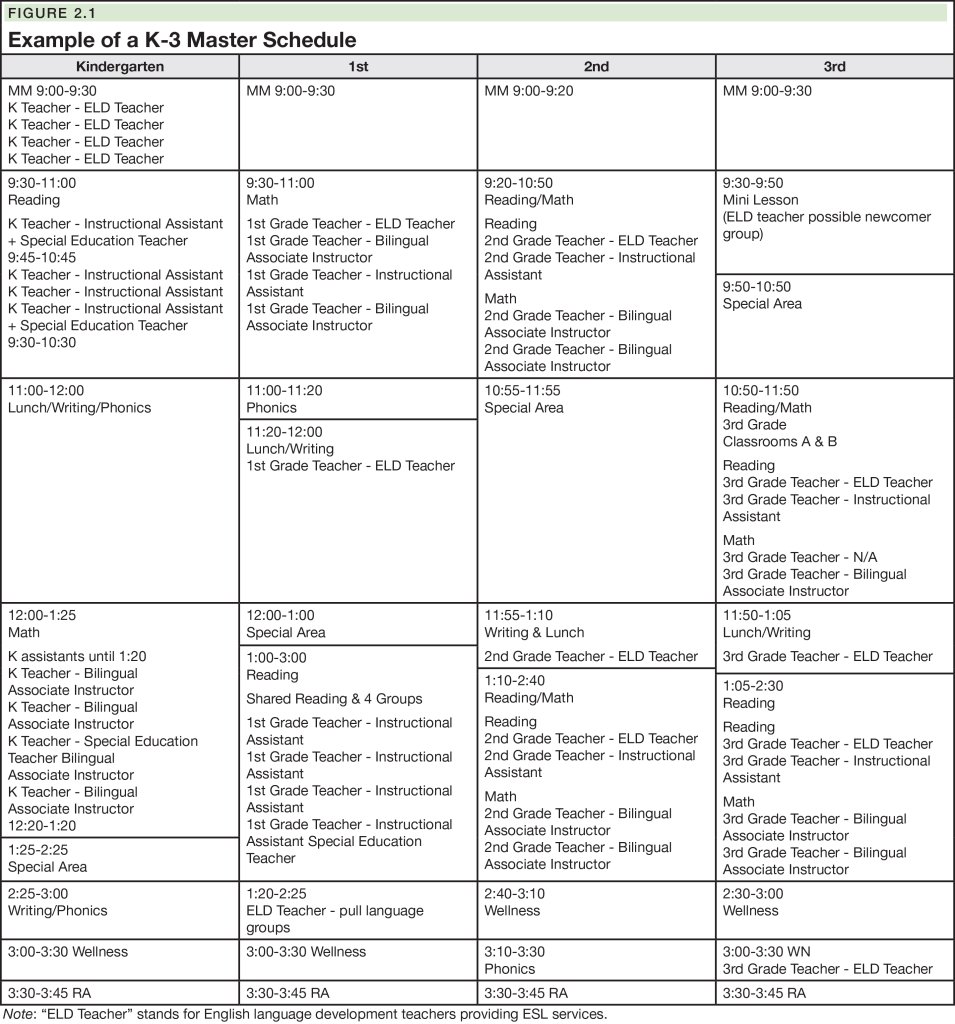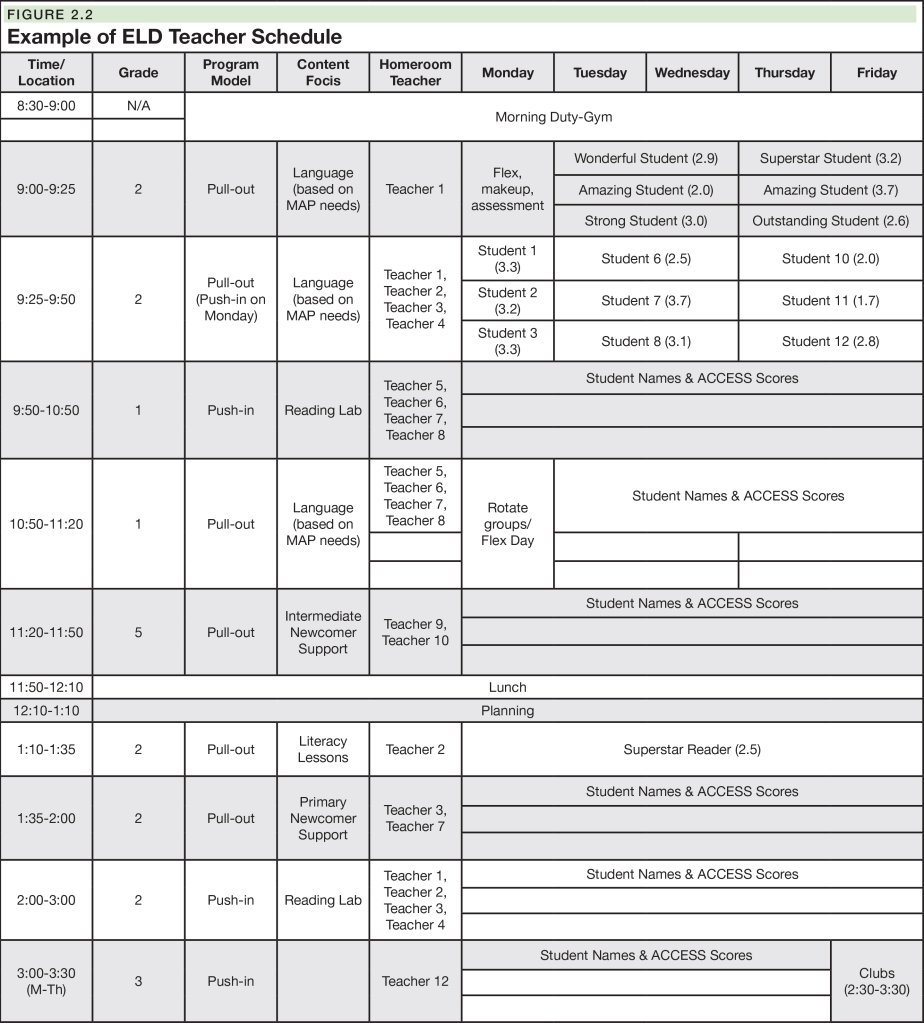Designing a Master Schedule to Support All Teachers
Careful scheduling that takes into account the needs of teachers across grade levels can maximize the amount of time they have to plan.
Your content has been saved!
Go to My Saved Content.As a visionary leader, you must keep an eye on the big picture and create systems and structures that work interdependently of one another. To that end, the master schedule is everything. One of its greatest advantages is the collaborative opportunities it provides. For example, the master schedule allows us to add an additional layer of support for all students and teachers in the form of additional staff who can help implement small-group instruction. This includes the intentional use of English language development (ELD) teachers, special education (SE) teachers, and instructional assistants. Struggle with content is one of the biggest causes of adverse student behaviors (Mitchell et al., 2018), so adding this layer of academic support is one of the most effective proactive supports we have implemented to decrease disruptive behaviors. Although that was not the initial intent of the master schedule, the impact it has had on decreasing disruptive behaviors in our building is undeniable.

If you are not currently in charge of your school’s master schedule, then there may be some initial resistance because, truthfully, a master schedule that truly honors collaboration and support for an entire building cannot honor the individualized needs of each teacher. Therefore, it is critical that you create and cultivate a culture that honors collaboration and teamwork. When I (Jill) first began to create my school’s master schedule, I asked staff to list the top three priorities they had in a schedule. Some of the priorities that emerged were extra support during math workshop, continuation of the reading lab, and dedicated WIN (what I need) time. Next, I asked each grade level to provide me with a copy of what they considered their ideal schedule. With those two pieces of information, I set out to create a master schedule that included the top three identified priorities and honored at least one component of everyone’s ideal schedule. Although creating a master schedule is often like navigating a giant game of Tetris, it will be worth every hour you spend on it.
When the master schedule is created with such intentionality, it sets the tone for the other schedules in the building. Special education services, English as a second language (ESL) programming, and other intervention schedules can be designed with individual students’ needs in mind to ensure that multiple data points and areas of focus are tightly aligned and to confirm students receive the support that maximizes their learning opportunities. Co-teaching is possible when co-planning exists. In addition to creating schedules that integrate collaborative opportunities for teachers and students, it is also important to ensure general education teachers share common planning times with ELD and SE teachers with whom they share students. It is during these times that ELD and SE teachers make recommendations and intentionally embed scaffolds and supports for lessons. During common planning time, collaborative partners should also discuss student progress data and determine instructional next steps for acceleration, intervention, and enrichment. Figure 2.1 shows a sample master schedule, and Figure 2.2 shows a sample schedule for an ELD teacher.


Common Planning
One of the must-haves in our master schedule is common planning time for teams of teachers. Effective collaboration is hard to achieve when teachers don’t have time in the workday to meet with one another. Although common planning is essential, leaders must also create a culture that values collaboration. When teachers experience the unlimited benefits of a professional learning community (PLC), they will never know how they functioned before that. PLCs, as defined by Hord (1997), are groups where teachers can investigate how to improve their practice together and take collective responsibility for implementing what they discover. This idea was transformed into a specific approach to collective team meetings in which teams establish clear goals, promote team building, gather data, undertake problem solving, and design interventions (DuFour et al., 2010). To clarify exactly what students are expected to learn and to monitor each student’s learning progress, PLCs should focus on the following four questions:
- What do we want all students to know and be able to do?
- How will we know if they learn it?
- How will we respond when some students do not learn?
- How will we extend the learning for students who are already proficient?
The tenets of these four questions seem simple enough, but there is a greater level of sophistication required to develop a highly functioning PLC. Our school was fortunate enough to be selected as a pilot school to train in this process. The training lasted for three years, and even though it was incredibly rigorous, it changed the way we approached teaching and learning—and in just three years, our students’ math proficiency tripled. In addition to increasing student achievement, this professional learning also reduced feelings of isolation and enhanced the collective efficacy of our staff. Teachers began to value the power of collaboration and had higher motivation and satisfaction for the job.
When schools put in the work, both students and staff win. We have experienced great success as a result of our PLC work; however, we must caution you about some of the pitfalls you need to avoid:
- PLCs should be administratively supported rather than administratively driven. You want teachers to own the data and make data-driven instructional shifts that support attainment of mastery for all students. If you are dictating agenda items and controlling the conversation, the ownership stays with you. To demonstrate the value you ascribe to PLCs, we suggest administrative attendance at all collaborative team meetings. When engaging in conversations with teachers, do so to clarify, consult, or celebrate. Try to develop a culture in which team leaders are responsible for creating the agendas and ensuring necessary data are available for each meeting. Instructional coaches should be available to support if needed, but it is essential to empower your teachers.
- Do not criticize in meetings. Highly functioning teams are those with members who have developed trust and can be vulnerable with one another. Criticism and control from administrators can shut this down and minimize the potential impact of the team.
- A PLC is who you are—not what you do. It is critical to help staff understand this.
When teachers see PLCs as part of the ingrained culture and not just a collection of compliance meetings, there is a shift from thinking about my students to our students. They understand the value of a team and the impact of collective efficacy. Shared responsibility increases the team’s productivity and decreases the siloed workload of individual teachers. In essence, it provides more time for teachers because they are not doing everything by themselves.
In addition to grade or subject groups meeting together, this structure provides support staff, such as ELD and SE teachers, with time and opportunity to meet and provide scaffolds for instruction, analyze disaggregated data, and provide embedded professional development.
Unit Planning Days
Although daily common planning time provides designated opportunities for student work and data analysis that can ultimately lead to instructional decision making about interventions, enrichment, and acceleration, deep dives into standards and thorough unit plan development require longer spans of uninterrupted time. Every year, one of our budgetary priorities is providing dedicated unit planning days to teams. When teachers have uninterrupted time to collaborate with one another, they can intentionally create units through a backward design model—which provides insight into students’ progression toward mastery, helps teachers measure the impact of instruction, and guides instructional decision making.
What does this look like in practice? Teams begin with the end in mind and create:
- Pre-assessments to review prior skills and consider possible misconceptions.
- Common standards-based assessments.
- Daily formative assessments.
- Performance assessment opportunities.
- Assessment rubrics so students have clear expectations.
They then create daily lessons that include:
- Lesson frames to use when tracking mastery of daily goals (e.g., I can...).
- Opportunities to activate background knowledge and provide experience to help students anchor new learning.
- A plan to address misconceptions.
Finally, teams ensure that each unit includes multiple opportunities to:
- Include diverse cultural perspectives.
- Consider the progression of standards to track student success and mastery.
- Engage in higher-level cognitive tasks.
- Demonstrate learning.
- Apply 21st century skills.
- Engage an authentic audience and make real-world connections.
- Extend the lesson for more proficient students.
Unfortunately, because of teacher shortages in our district (which is, admittedly, a universal phenomenon), providing substitutes to secure these unit planning days was prohibited in the wake of the COVID-19 pandemic (even though we had budgeted for it). Knowing the value this time had for our teachers, not having unit planning days was simply not an option for us. Therefore, we had to be creative with our plans and utilize staff in a way that still made this valuable opportunity possible.
We brought the assistant principal, mental health practitioner, counselor, and compassion teacher on board and had them rotate among the classes and each provide an hour of instruction that focused on social-emotional and social justice needs. This coverage, combined with the teachers’ own planning time, came to five hours of uninterrupted unit planning time. Even though it didn’t completely mirror the full-day unit planning we had in the past, it still provided valuable extended planning time, engaged students in SEL support, and didn’t cost the school any unbudgeted funding.
Excerpt from: What Can I Take Off Your Plate? A Structural—and Sustainable—Approach to Countering Teacher Burnout (pp. 27–37), by J. Handley and L. Donnelly, 2024, ASCD. Copyright 2024 by ASCD. Reprinted with permission.
